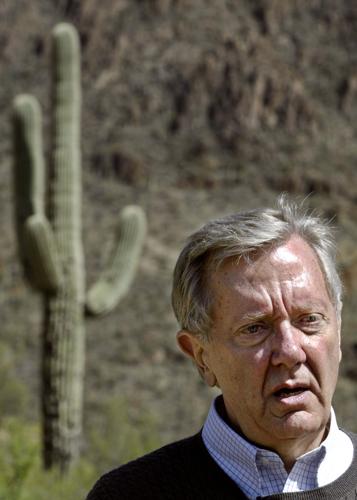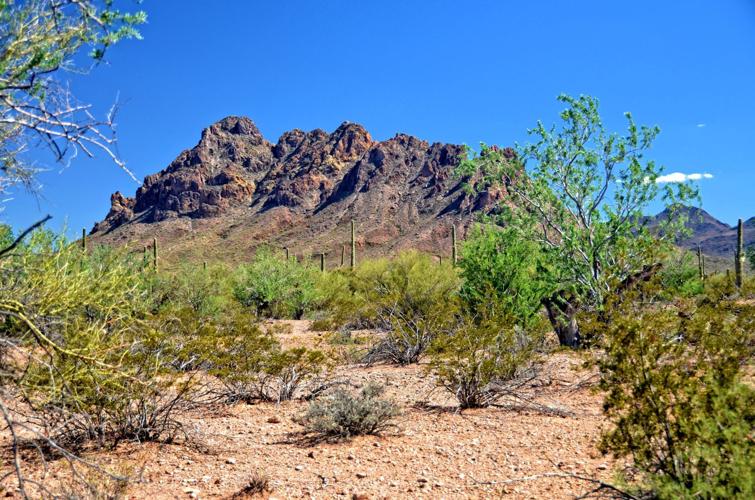The former U.S. interior secretary and Arizona governor who helped create Ironwood Forest National Monument is blasting Asarco for seeking the removal of 11,000 acres from the preserve to mine copper.
The multinational company is simply trying to take advantage of a favorable political climate during the Trump administration, said Bruce Babbitt in an interview this week.
And while Asarco’s formal request was to modify the monument’s boundaries, Babbitt accused the company of framing its request in a way to make a case for its elimination.
Former President Bill Clinton designated the 129,000-acre monument in the Sonoran Desert northwest of Tucson in June 2000 at the recommendation of Babbitt, his interior secretary. An additional nearly 60,000 acres of state land and some private land are included within the boundaries.
The designation came three months after the Pima County Board of Supervisors unanimously voted to support the monument’s creation. The Pinal County board later followed suit with a unanimous recommendation.
This summer, Asarco wrote the Interior Department seeking to have nearly 10 percent of the monument’s federally owned land removed. It said it can’t “make economic use” of 4,050 acres in mining claims and 880 acres of land it owns within monument boundaries because of the designation. Those lands adjoin its existing Silver Bell Mine, which has operated for more than 65 years, wrote Nancy Johannesmeyer, Asarco’s senior environmental affairs manager.
In addition, a coalition of mining interest groups also asked the Interior Department to shrink Ironwood and to reduce in size or eliminate three of four other Arizona monuments Clinton created.
Clinton, a Democrat, had approved the Arizona monuments toward the end of his tenure to leave behind a legacy of conservation. Today, Republican President Trump’s Interior Secretary Ryan Zinke is conducting a review of three of those and 14 other monuments created by past administrations to see if they should be shrunk or eliminated.
Zinke submitted recommendations from the review to Trump a week ago. The administration hasn’t released them to the public.
Babbitt said he’s indignant at Asarco’s request because the Ironwood and other Arizona monuments have achieved important conservation results.
“When I talk about this around the country in terms of all these other things Zinke is trying to do, I remind people that this monument was endorsed by a unanimous vote of county supervisors,” Babbitt said. “What Zinke is saying is that ‘I’m looking at these items and there is no local support.’ But there was. He is fronting for the mining industry.”
In its June 30 letter, Asarco said much of the Ironwood land failed to meet a host of criteria under the federal Antiquities Act for designating a monument. Among those are that the monument be of the smallest area needed to properly care for the objects to be managed.
It also argued that too much of the land’s desert landscape doesn’t qualify, because the act’s main purpose is to “preserve the works of man” and that the cacti and other desert plants aren’t objects of historic or scientific interest.
Other large, federally owned special management areas run by the Bureau of Land Management already exist to protect the types of plants and animals that Ironwood contains, “and there was no justifiable reason to designate 189,600 acres as a national monument in this area,” Johannesmeyer wrote.
“Effectively, they are saying that nothing legally justifies creation of a national monument,” said Babbitt, who works full time advising California Gov. Jerry Brown on water issues. “I think that’s a real kind of an insight into what this is all about. They’re waking up saying we have a chance to get them to abolish the monument. They start by saying nothing out there merits protection, that it’s no different than any other acre of land in the Arizona desert.”
As for Asarco’s legal arguments, “My only thought is they misread the language of the act. The act says to protect objects of scientific importance,” and the monument’s Sonoran Desert lands are scientifically important, said Babbitt, who was Arizona’s governor from 1978 to 1987.
Johannesmeyer didn’t respond to several requests from the Star seeking comment on Babbitt’s statements.
Rick Grinnell, vice president of the Southern Arizona Business Coalition, which signed the mining groups’ letter to the Interior Department, said he believes the Clinton administration had a lapse in judgment by not allowing interest groups more time to make their case on the monument issue.
“The three-month period, when you are talking about removing a significant amount of property from development, including 60,000 acres of Arizona state trust land,” wasn’t long enough, Grinnell said Thursday.
At the time the monument was created, several Tucson-area scientists and environmentalists cited a very dense concentration of ironwood trees there and said the ironwood habitat nurses 674 animal and plant species. They also mentioned the presence of the endangered Nichols turk’s head cactus and lesser long-nosed bat and the rare and then-endangered cactus ferruginous pygmy owl.
The public discussion over the Ironwood monument proposal in 2000 was relatively peaceful. Several Tucson environmentalists and Pima County Administrator Chuck Huckelberry said recently that they don’t recall hearing Asarco officials raise public concerns.
But in her letter, Asarco’s Johannesmeyer wrote that in May 2000, the Silver Bell Mine’s then-general counsel met with the Interior Department’s solicitor and staff to discuss its concerns and to seek a “buffer” for the Silver Bell Mine.
On June 5, 2000, senior Silver Bell management officials met with Babbitt to suggest creating a mineral exploration district within the monument, she wrote.
“Secretary Babbitt indicated he would consider the proposal. Four days later, on June 9, 2000, the monument proclamation was issued and all lands within the (monument) were withdrawn from mineral entry,” Johannesmeyer wrote.
Since then, Asarco has paid $326,000 to maintain its claims, and its inability to mine the claims has cost it $146 million, she wrote.
Babbitt said this week that he recalled the meeting and the issues Asarco raised. But the monument’s proclamation contained clear language saying that the protections were subject to “valid existing rights,” he said.
“Then, they’re manufacturing all these crybaby arguments about unpatented claims. The monument proclamation recognizes those unpatented claims, that they have valid rights” that companies can explore, Babbitt said.
“There is no reason to change anything,” he added. An unpatented mining claim is one filed on land that a company doesn’t own.
Mining industry officials, however, say it’s virtually impossible to explore claims within monuments because they first must prove the claims are valid, having an economic value. That’s impossible to prove without exploring them, they say.






